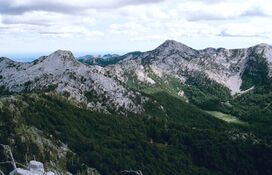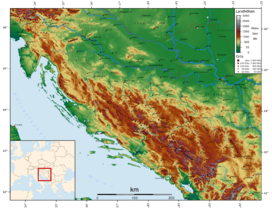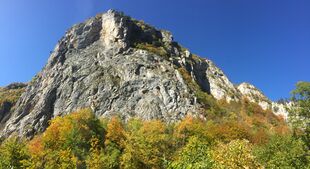الألپ الدينارية
| الألپ الدينارية Dinaric Alps | |
|---|---|
| Dinarides | |
 Orjen spreads between Bosnia and Herzegovina and Montenegro and is the most heavily karstified range of the Dinarides. | |
| أعلى نقطة | |
| القمة | Maja Jezercë in Albania |
| الارتفاع | 2،694 m (8،839 ft) |
| الإحداثيات | 45°N 17°E / 45°N 17°E |
| الأبعاد | |
| الطول | 645 km (401 mi) NW-SE |
| المساحة | 200،000 km2 (77،000 sq mi) |
| الجغرافيا | |
| Countries | Albania, Bosnia and Herzegovina, Croatia, Italy, Montenegro, Kosovo, Serbia and Slovenia |
| يحد | Julian Alps |
| الجيولوجيا | |
| عمر الصخر | Mesozoic era |
| نوع الصخر | Sedimentary |
الألپ الدينارية، هي سلسلة جبال في جنوب أوروپا وجنوب وسط أوروبا، فتفصل شبه جزيرة البلقان القارية عن البحر الأدرياتي. وتمتد من إيطاليا في الشمال الغربي عبر سلوڤنيا، كرواتيا، البوسنة والهرسك، صربيا، كوسوڤو،[a 1] والجبل الأسود وألبانيا في الجنوب الشرقي.[1][2]
وتمتد بمساحة 645 كيلو متر على ساحل البحر الأدرياتي (شمال غرب-شمال شرق)، من الألپ الجولية في شمال غرب سار-كوراب، حيث يتغير اتجاه الجبل من الشمال إلى الجنوب. أعلى جبل في الألپ الدينارية هو جبل پروكلتيجه، ويقع على الحدود الشرقية للجبل الأسود والشمالية لألبانيا، ويوجد فيه "قمة كرست" التي يصل إرتفاعها إلى 2692 متر. The Accursed Mountains are the highest section of the entire Dinaric Alps; this section stretches from Albania to Kosovo and eastern Montenegro. Maja Jezercë, standing at 2،694 متر (8،839 ft) above the Adriatic, is the highest peak and is located in Albania.
The Dinaric Alps are one of the most rugged and extensive mountainous areas of Europe, alongside the Caucasus Mountains, Alps, Pyrenees, Carpathian Mountains and Scandinavian Mountains.[بحاجة لمصدر] They are formed largely of Mesozoic and Cenozoic sedimentary rocks of dolomite, limestone, sandstone and conglomerates formed by seas and lakes that once covered the area. During the Alpine earth movements that occurred 50 to 100 million years ago, immense lateral pressures folded and overthrust the rocks in a great arc around the old rigid block of the northeast. The main tectonic phase of the orogenesis in the area of the Dinaric Karst took place in Cenozoic Era (Paleogene) as a result of the Adriatic Microplate (Adria) collision with Europe, and the process is still active.[3] The Dinaric Alps were thrown up in more or less parallel ranges, stretching like necklaces from the Julian Alps as far as northern Albania and Kosovo, where the mountainous terrain subsides to make way for the waters of the Drin River and the plains of Kosovo.
الاسم
الدينارية مسماة على اسم جبل دينارا (1,831 م)، القمة البارزة في وسط سلسلة الجبال على حدود الجزء الدلماني من كرواتيا والبوسنة والهرسك.[4] أسماء السلسلة في اللغات المحلية تتضمن ألبانية: Alpet Dinarike [alpɛt dinaɾikɛ] أو Dinaret؛ إيطالية: Alpi Dinariche [alpi dinarike]؛ قالب:Lang-sh-Cyrl-Latn أو Динарско горје Dinarsko gorje [dìnarskòː ɡòːrjeː]؛ Slovene: Dinarsko gorstvo [dìnarskòː ɡòːrstvòː].
الجيولوجيا

The Dinaric Karst region is built mostly of Mesozoic limestone and dolomite deposited on top of a huge Bahama-type carbonate platform,[5] while a few kilometers thick carbonate successions have been deformed during the Alpine orogenesis.[6] The main tectonic phase of the Alpine orogenesis in the Dinaric Karst region took place in the Cenozoic Era (Paleogene) as a result of the Adriatic microplate (Adria) collision with the Serbo-Macedonian and Rhodope Massifs,[7] and the process is still active.[3] The Mesozoic limestone forms a very distinctive region of the Balkans, notable for features such as the Karst Plateau, which has given its name to all such terrains of limestone eroded by groundwater. The Dinarides are known for being composed of karst – limestone rocks – as is Dinara, the mountain for which they were named.[4] The Quaternary ice ages had relatively little direct geologic influence on the Balkans. No permanent ice caps existed, and there is little evidence of extensive glaciation. Only the highest summits of Durmitor, Orjen and Prenj have glacial valleys and moraines as low as 600 m (1،969 ft). However, in the Accursed Mountains (الصربية الكرواتية: [Prokletije] Error: {{Lang}}: text has italic markup (help)), a range on the northern Albanian border that runs east to west (thus breaking the general geographic trend of the Dinaric system), there is evidence of major glaciation. One geological feature of great importance to the present-day landscape of the Dinarides must be considered in more detail: that of the limestone mountains, often with their attendant faulting. They are hard and slow to erode, and often persist as steep jagged escarpments, through which steep-sided gorges and canyons are cleft by the rivers draining the higher slopes.[بحاجة لمصدر]
The partially submerged western Dinaric Alps form the numerous islands and harbors along the Croatian coast.
Rivers in Dinaric karst
The most extensive example of limestone mountains in Europe are those of the Karst of the Dinaric Alps. Here, all the characteristic features are encountered again and again as one travels through this wild and thinly populated country. Limestone is a very porous rock, yet very hard and resistant to erosion. Water is the most important corrosive force, dissolving the limestone by chemical action of its natural acidity. As it percolates down through cracks in the limestone it opens up fissures and channels, often of considerable depth, so that whole systems of underground drainage develop. During subsequent millennia these work deeper, leaving in their wake enormous waterless caverns, sinkholes and grottoes and forming underground labyrinths of channels and shafts. The roofs of some of these caverns may eventually fall in, to produce great perpendicular-sided gorges, exposing the surface to the water once more.
The Dinaric rivers carved many canyons characteristic for Dinaric Alps, and in particular karst. Among the largest and most well known are the Neretva, the Rakitnica, the Prača, the Drina, the Sutjeska, the Vrbas, the Ugar, the Piva, the Tara, the Komarnica, the Morača, the Cem/Ciijevna, the Lim, and the Drin.
Only along the Dinaric gorges is communication possible across the Karst, and roads and railways tunnel through precipitous cliffs and traverse narrow ledges above roaring torrents. A number of springs and rivers rise in the Dinaric range, including Jadro Spring noted for having been the source of water for Diocletian's Palace at Split.[8] At the same time, the purity of these rocks is such that the rivers are crystal clear, and there is little soil-making residue. Water quality testing of the Jadro River, for example, indicates the low pollutant levels present.[9] Rock faces are often bare of vegetation and glaring white, but what little soil there is may collect in the hollows and support lush lime-tolerant vegetation, or yield narrow strips of cultivation.[بحاجة لمصدر]
الأنشطة البشرية
Ruins of fortresses dot the mountainous landscape, evidence of centuries of war and the refuge the Dinaric Alps have provided to various armed forces. During the Roman period, the Dinarides provided shelter to the Illyrians resisting Roman conquest of the Balkans, which began with the conquest of the eastern Adriatic coast in the 3rd century BC. Rome conquered the whole of Illyria in 168 BC, but these mountains sheltered Illyrian resistance forces for many years until the area's complete subjugation by 14 AD. More recently, the Ottoman Empire failed to fully subjugate the mountainous areas of Montenegro[broken anchor]. In the 20th century, too, the mountains provided favourable terrain for guerrilla warfare, with Yugoslav Partisans organising one of the most successful Allied resistance movements of World War II.[بحاجة لمصدر]
The area remains underpopulated, and forestry and mining remain the chief economic activities in the Dinaric Alps. The people of the Dinaric Alps are on record as being the tallest in the world, with an average male adolescent height of 185.6 cm (6 ft 1.1 in).[10] The people of Bosnia and Herzegovina have the highest recorded average of any single country, with 183.9 cm average for men and 171.8 cm for women.[11][12][13]
الممرات الجبلية
الممرات الجبلية الرئيسية في جبال الألپ الدينارية:[14]
- Postojna Gate (Postojnska vrata), Slovenia (606 متر),
- Vratnik pass, Croatia (850 متر)
- Knin Gate (Kninska vrata) (حوالي 700 متر)
- Vaganj (1137 متر)
- Ivan-Saddle (Ivan-sedlo), Bosnia-Herzegovina (967 متر)
- Cemerno, Bosnia-Herzegovina (1329 متر)
- Crkvine, Montenegro (1045 متر)
- Cakor, Montenegro (1849 متر)
الأنفاق
- Tuhobić Tunnel, كرواتيا
- Sveti Rok Tunnel, كرواتيا
- Mala Kapela Tunnel, كرواتيا
الجبال والهضاب

Legend:
A1: The area of the North Adriatic - the territory of Istria and the Kras area
A2: Northern Adriatic - North Adriatic islands
A3: Mountains of Dalmatia - Central mountain range
A4: Dalmatian Mountains - Coastal Mountain Range
A5: The mountains of southern Dalmatia and Mediterranean Herzegovina
A6: The islands of Central and South Adriatic and Peljesac
A7: Primorje Mountains of Montenegro
A8: Coastal and Central Montenegro Mountains - Katunska karst flattening
A9: Mountains of the Montenegrin Rudina
A10/11: Mountains of Low Herzegovina
B1: Group of Trnova herod
B2: Snežnik and Gorski kotar plateaus
B3: Notran plateau
B4: Great Chapel (Velika Kapela)
B5: Massive Velebit
B6: Little Chapel (Mala Kapela) and Lika Center
B7: Massif Lička Plješivica (Plješevica)
B8: Massive Dinara
B9: Šator
B10: Cincar
B11: Klekovača (S) and Grmeč (N)
B12: Raduša
B13: Čvrsnica
B14: Massive Prenj
B15: High mountains of Herzegovina - Velež and Herzegovinian Rudine
B16: Mountains of High Herzegovina - Mountain range of Crvanj-Lebršnik
B17: Zelengora Group
B18: Bioč-Maglic-Volujak Group
B19: Vranica Group
B20: Bjelašnica (Southern Sarajevo Mountains)
B21: Mountain range Golija-Vojnik
B22: Group Switches
B23: Durmitor area
B24: Sinjajevina
B25: The Moravian-Fallen Mountains and Maganik
B26: Ljubišnja
B27: Massive Bjelasica
B28: Komovi
B29: Visitor
B30: Kučke planine (Žijovo)
B31: Albanian Alps
C1: Group of Kočevski Rog
C2: Žumberak / Gorjanci Group
C3: Central and Eastern Bosnia Mountains - Vlašić Group
C4: Central Bosnia Mountains
C5: Eastern Bosnia Mountains
C6: Central and Eastern Bosnia Mountains - Jahorina Group
C7: Mountains of Stara Vlaha and Raska (Sandžak) - Polymers-Podrinje Group
C8: Mountains of Stara Vlaha and Raška (Sandžak) - Zlatarsko-pešterska Group
C9: Mountains of the Old Mountains - the central group
C10: Mountains of Serbia - Podrinje-valjevo mountains
C11: Pre-Dinaric Mountains: Kozara (NW) och Majevica (SE).
توجد الجبال والهضاب ضمن سلسلة الألپ الدينارية في المناطق التالية:
ألبانيا
البوسنة والهرسك
|
كرواتيا
كوسوڤو
- Đeravica/Gjeravica
- Gusan/Maja Gusanit
- Marijaš/Marijash
- Veternik/Veterniku
- Bogićaj/Maja Bogiçaj
- Lićenat/Leqinat
الجبل الأسود
- Bijela gora means "White Mountain" in Montenegrin, which is the opposite of "Crna Gora" or "Black Mountain" which is the local name for Montenegro
- Durmitor
- Orjen
- Zla Kolata (bordering Albania; Kolata e Keq in Albanian)
صربيا الوسطى
سلوڤينيا
|
|
هوامش ومصادر
هوامش:
- ^ Kosovo is the subject of a territorial dispute between Serbia and the local Albanian majority. The Assembly of Kosovo declared its independence on 17 February 2008, a move that is recognised and the Republic of China (Taiwan), but not by Serbia, which claims it as part of its sovereign territory.
مصادر:
- ^ Profile, dictionary.reference.com; accessed 25 August 2015.
- ^ "Visit Dinaric Alps".
- ^ أ ب Korbar, Tvrtko (2009). "Orogenic evolution of the External Dinarides in the NE Adriatic region: A model constrained by tectonostratigraphy of Upper Cretaceous to Paleogene carbonates". Earth-Science Reviews. 96 (4): 296–312. Bibcode:2009ESRv...96..296K. doi:10.1016/j.earscirev.2009.07.004.
- ^ أ ب Mladen Garasic; Davor Garasic (1 April 2015). "Speleogenesis in Dinaric karst area". EGU General Assembly Conference Abstracts. 17: 10058. Bibcode:2015EGUGA..1710058G.
- ^ Vlahović, Igor; Tišljar, Josip; Velić, Ivo; Matičec, Dubravko (2005). "Evolution of the Adriatic Carbonate Platform: Palaeogeography, main events and depositional dynamics". Palaeogeography, Palaeoclimatology, Palaeoecology. 220 (3–4): 333–360. doi:10.1016/j.palaeo.2005.01.011.
- ^ Schmid, Stefan M.; Bernoulli, Daniel; Fügenschuh, Bernhard; Matenco, Liviu; Schefer, Senecio; Schuster, Ralf; Tischler, Matthias; Ustaszewski, Kamil (2008). "The Alpine-Carpathian-Dinaridic orogenic system: Correlation and evolution of tectonic units" (PDF). Swiss Journal of Geosciences. 101: 139–183. doi:10.1007/s00015-008-1247-3. S2CID 55108896.
- ^ Kilibarda, Zoran; Schassburger, Alec (1 October 2018). "A diverse deep-sea trace fossil assemblage from the Adriatic Flysch Formation (middle Eocene – middle Miocene), Montenegro (central Mediterranean)". Palaeogeography, Palaeoclimatology, Palaeoecology. 506: 112–127. doi:10.1016/j.palaeo.2018.06.023. S2CID 134665429. Retrieved 23 November 2022.
- ^ "C.Michael Hogan, "Diocletian's Palace", A. Burnham ed, 6 October 2007". The Megalithic Portal. Retrieved 19 August 2012.
- ^ Štambuk-Giljanović, Nives (2006). "The Pollution Load by Nitrogen and Phosphorus in the Jadro River". Environmental Monitoring and Assessment. 123 (1–3): 13–30. doi:10.1007/s10661-005-9066-8. PMID 17054013. S2CID 21572417.
- ^ Pineau, JC; Delamarche, P; Bozinovic, S (1 September 2005). "Les Alpes Dinariques : un peuple de sujets de grande taille Average height of adolescents in the Dinaric Alps". Comptes Rendus Biologies. 328 (9): 841–6. doi:10.1016/j.crvi.2005.07.004. PMID 16168365.
This study contributes to an update of average heights among European populations. Our investigation covering 2705 boys and 2842 girls aged 17 years, shows that, contrary to the general belief, adolescents of the Dinaric Alps are, on average, the tallest in Europe. With an average height of 185.6 cm, they are taller than Dutch adolescents (184 cm on average).
- ^ Stevo Popović; Gabriela Doina Tanase; Duško Bjelica (2015). "Body Height and Arm Span in Bosnian and Herzegovinian Adults" (.pdf). mjssm.me (in الإنجليزية). Montennegro Journal of Sports Sci. Medicine 4 (2015) 1: Original scientific paper. pp. 29–36. Retrieved 4 September 2016.
- ^ "Countries with the Tallest Average Heights".
- ^ "BiH na prvom mjestu liste zemalja s najvišim ljudima u svijetu".
- ^ Summitpost. Dinaric Alps: Passes in the Dinaric Alps, accessed 11-19-2008
وصلات خارجية
- Pages using gadget WikiMiniAtlas
- Short description is different from Wikidata
- Coordinates on Wikidata
- Wikidata value to be checked for Infobox mountain
- Articles with unsourced statements from September 2017
- Articles containing ألبانية-language text
- Pages using Lang-xx templates
- Pages with plain IPA
- Articles containing إيطالية-language text
- Pages with إيطالية IPA
- Articles containing صربو-كرواتية-language text
- Articles containing Slovene-language text
- Lang and lang-xx template errors
- Articles with unsourced statements from August 2015
- Articles with hatnote templates targeting a nonexistent page
- Pages with broken anchors
- دينارية، الألپ
- سلاسل جبلية في ألبانيا
- جبال البوسنة والهرسك
- جبال كرواتيا
- جبال الجبل الأسود
- سلاسل جبلية في صربيا
- جبال كوسوفو
- أقاليم فيزيوغرافية
- سلاسل جبلية في سلوڤينيا



